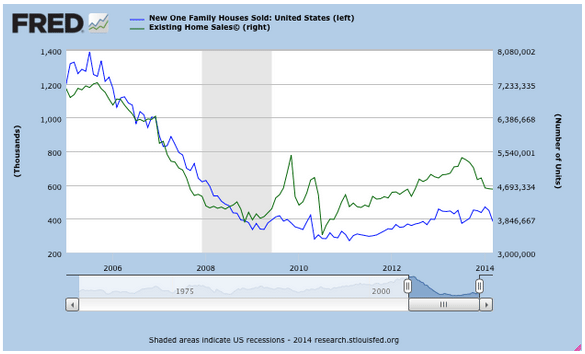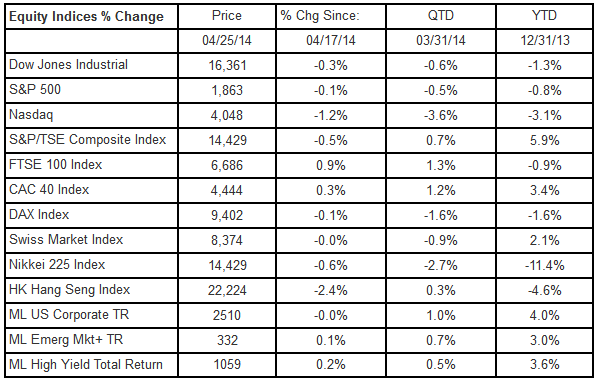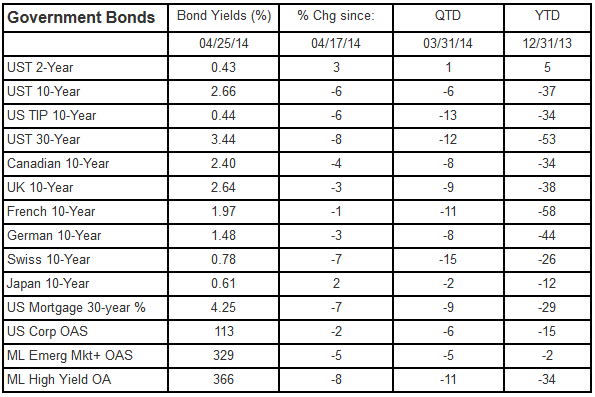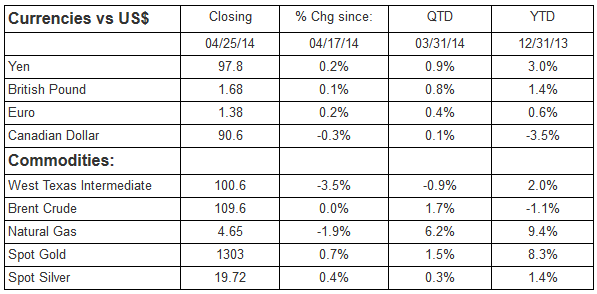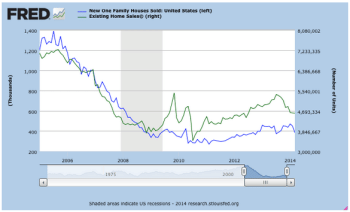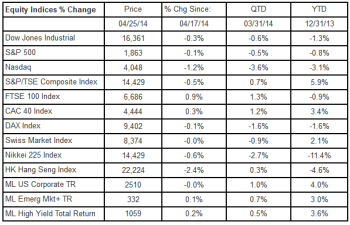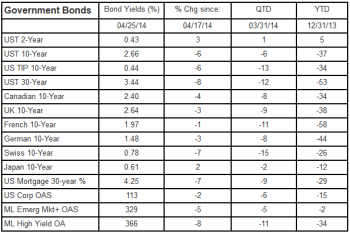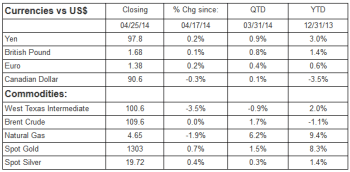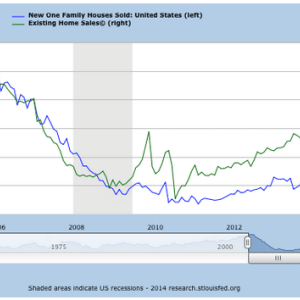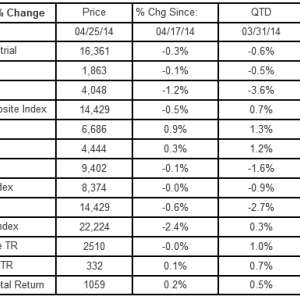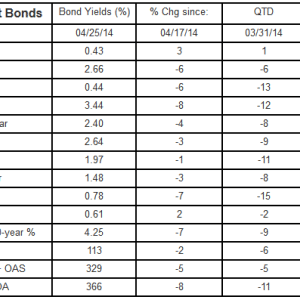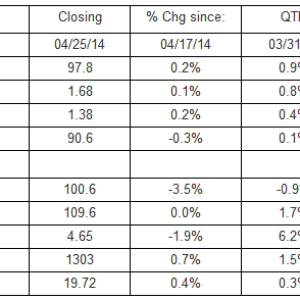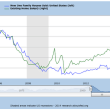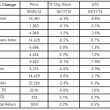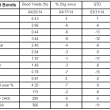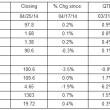John Davidson’s Economic Comments: Week ending April 25
Both earnings and economic reports have been positive, but the uncertainty imbedded in the geopolitical risks in the Ukraine has put a damper on the equity market and driven bond rates even lower this week. Equity markets were lower in North America, Germany and Asia; and government 10-year bond yields were lower on the week. The U.S. dollar fell against the Yen, Pound and Euro; WTI oil and natural gas commodity prices were lower, but metal commodity prices were higher on the week.
Perspective:
The threat of geopolitical events, not just the event itself, has had significant impact on financial markets. This week serves as a good example. Both the economic and earnings releases this week should have been a positive for the equity markets. The global economy has shown signs of a global synchronized expansion. Markit's flash PMI's (except for China) for April remain in the expansion zone. Positive earnings surprises were reported by 73 percent of the S&P companies so far this quarter. Yet, the situation in the Ukraine continued to deteriorate with the abandonment of the de-escalation agreement this week. Sanctions have been the tool of choice for those who want to keep the Russians out of the Ukraine; but, like all remedies, sanctions are a two-edged sword with those that are nearest the blade in a disproportionate danger of the back-swing.
Economic Releases:
While the overall economic picture in the U.S. has been rebounding from the severe winter storms, U.S. housing has been softer. Some have suggested that the increased interest rates have had an impact, but the average 30-year mortgage rate of 4.25 percent (see the Bond Markets table) is actually 29 basis points lower than it was at year-end. In March, Existing Home Sales (green in the chart) dipped a tick to 4.59 million; this was better than expected, but still -7.5 percent below the measure of a year ago. More unsettling, New Home Sales (blue in the chart) fell to 384,000. Furthermore, mortgage applications were down -3.3 percent the week of April 18.
Other Economic Releases
On the positive side in the U.S., New Orders for Durable Goods rose 2.6 percent in March; ex-transportation, Orders rose 2.0 percent; both numbers were better than consensus expectations and the ex-transportation data was beyond the range of expectations. The University of Michigan's Consumer Sentiment rose two points in its preliminary estimate for April. Initial Jobless Claims rose to 329,000 the week of April 19; but, Continuing Claims moved to a new-recovery low of 2.68 million. The Markit Purchasing Managers' Manufacturing Index flash report for April was down only a tick to 55.4, but remained well into the expansion zone (above 50). These reports follow the previous week's better than expected Retail Sales and Industrial Production reports as well as as Economists Ed Hyman's ISI Company Surveys, which rose eight ticks this week to 54.0, the "highest reading in almost eight years!"
In the European Union the Markit composite flash for April rose to 54.0; Manufacturing PMI rose to 53.3; Services PMI slipped to 53.1. Germany's flash for Composite, Manufacturing and Services all rose to 56.3, 54.2 and 55.0 respectively. In the UK, Retail Sales rose only +0.1 percent in March, but that was better than the expectations of a -0.4 percent loss.
China's PMI Markit Manufacturing Index rose two ticks to 48.3 in April, but remained in the contraction zone below 50. Japan's All Industry Index fell -1.1 percent in February.
Equities Markets:
Equity markets experienced mixed results with the opposing forces of improving economic conditions and positive earnings surprises versus the geopolitical tensions in the Ukraine that cause investors to seek safety. Factset reported that of the 240 companies in the S&P 500 that have reported earnings, 73 percent have beaten the analysts’ earnings estimates and 54 have beaten the revenue estimates; this level of earnings surprise was similar to those of recent quarters. More companies gave negative than positive forward guidance (some of this may be to manage expectation and produce positive surprises in the future). Yet, the S&P 500 forward price to estimated forward earnings is 15.3, within the range of fair valuation.
Bond Markets:
Government Bond yields were driven by the flight to safety. The yield curve flattened as two-year rates rose while yields of bonds with longer maturities fell. Credit spreads narrowed as investors were willing to take on more credit risk. For perspective, high yield investors who are willing to be paid 366 basis points to take on the risks in the high yield market demanded over 1,800 basis points at the end of 2008 and 650 basis points at the end of 2009 to assume similar risks.
Currencies & Commodities:
The U.S. dollar fell against the Yen, Pound and Euro, but rose against the Looney this week.(Note: the Looney is the reference to the image on the Canadian Dollar.) The spread between WTI and Brent Oil widened with the tension in the Ukraine. WTI fell while the Brent was unchanged. metals prices rose on the week.
John W. Davidson, CFA, started writing these Comments more than a decade ago as a personal discipline when he was promoted from portfolio manager to chief investment officer and CEO.

Most recently, he was the president of PartnerRe Asset Management Corporation, responsible for the management of PartnerRe's invested assets, which grew from $4 billion to $12 billion during his tenure. After joining PartnerRe in the fall of 2001, he hired the staff, built the trading floor and created the infrastructure to manage both fixed income and equity assets internally. He retired from PartnerRe at the end of 2008 and moved to Maine, where he focused on board work.
He has more than 35 years of industry experience, including positions with investment management responsibility for separate institutional accounts, mutual funds, trusts and insurance assets. Prior to joining PartnerRe, he served as president and chief executive officer of two other investment management companies. For various companies he has held positions as chief investment officer, chief economist, head of fixed income and portfolio manager. As a portfolio manager, Davidson managed and traded U.S. Government Securities as well as futures and options on fixed income instruments.
His real world experience is backed by a strong academic foundation, which includes earning a Master of Business Administration in finance and a Master of Arts in mathematics from Boston College, as well as a Bachelor of Arts, cum laude, in economics from Amherst College. He holds the professional designation of chartered financial analyst.
His experiences and credentials have brought him to the public as a television commentator and conference speaker. In addition to his frequent past appearances on CNBC, CNNfn, Bloomberg TV and Yahoo FinanceVision, he appeared as a special guest on Wall $treet Week with Louis Rukeyser. Reuters, Bloomberg and other business press services have quoted his views on the market. He has taught CFA preparation programs, as well as other courses offered by the Stamford and Boston CFA Societies, and the National Graduate Trust Officers' School.
Davidson is a natural leader in both his professional and personal life, having developed those skills early in his career as a naval officer. He spent three years on active duty, which included a year on the rivers of Vietnam, and 24 years in the Naval Reserve, from which he retired as a captain in 1994.
Davidson is treasurer and board member of the Camden Conference. He is also on the investment committee of the Pen Bay Health Foundation. He serves as an independent trustee for mutual funds.
In his leisure time, he is an active sailor, tennis player and skier. With his wife, Barbara, he renovated a 100+-year-old home in Camden, where they enjoy spending time with their two golden retrievers and having visits from their five children. He can be reached at jwdbond@me.com.
Event Date
Address
United States

